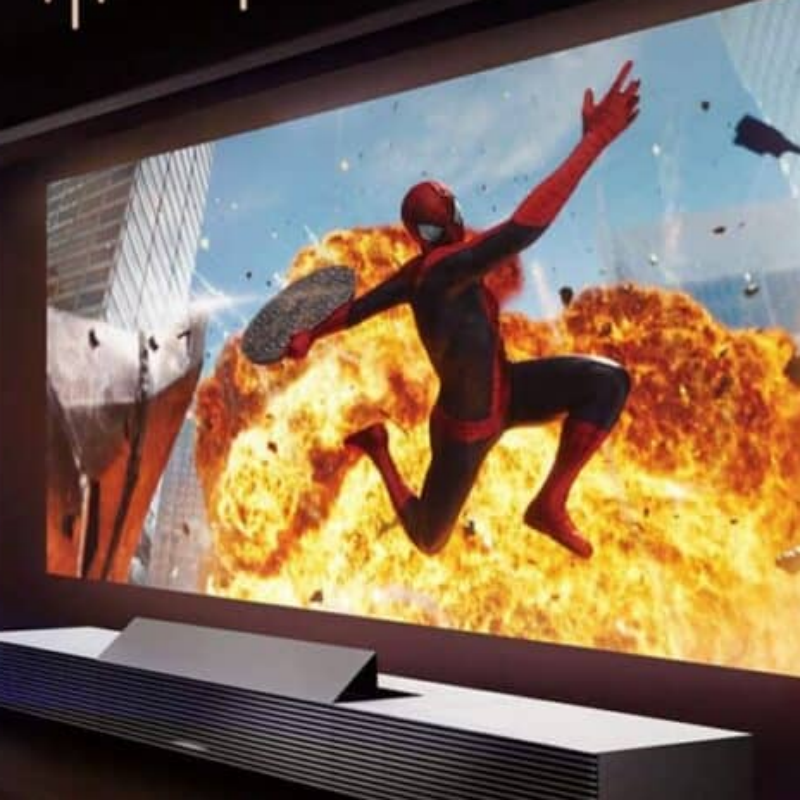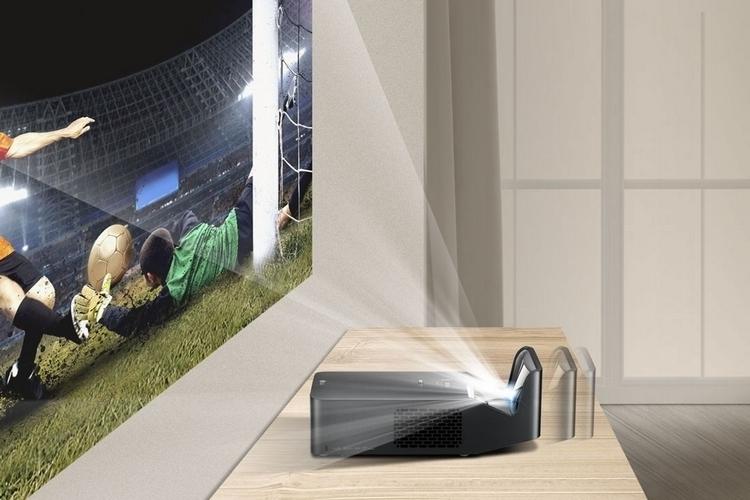Unlocking Cinematic Brilliance: A Deep Dive into High-Quality Long-Throw Projectors
By hqt | 10 10 月 2023
Projectors have long held a significant place in the realm of home entertainment. Historically linked to the magic of cinema, they bring to life visuals, capturing imaginations and transporting viewers to different worlds, all from the comfort of their living rooms. As the desire for larger, more cinematic viewing experiences has grown, so too has the technology behind these projection marvels, evolving to cater to various viewing environments and preferences.

Enter the concept of the high-quality long-throw projector. In simple terms, a high-quality long-throw projector is designed to be positioned further away from the screen or wall it’s projecting onto, as compared to its short or ultra-short throw counterparts. This distance termed the ‘throw’, is crucial in determining the size of the projection. High-quality long-throw projectors are especially suited for larger rooms or setups where the projector can be placed at a significant distance from the viewing surface, replicating the expansive and immersive experience akin to commercial theaters.
Projectors, while sharing a common purpose of projecting images onto a surface, come with varying functionalities based on their design and intended use. One of the primary classifications revolves around their “throw” distances.
1) Ultra-Short Throw (UST) Projectors: These are designed to be placed extremely close to the projection surface, often just a few inches away. They are ideal for tight spaces or environments where it’s challenging to have any significant distance between the projector and the screen. UST projectors often find their place in interactive presentations, classrooms, or small rooms.
2) Short Throw Projectors: Positioned slightly further away than UST projectors but still relatively close to the screen, short Throw projectors are great for medium-sized rooms where you want a big image but don’t have the luxury of placing a projector far back. They are especially beneficial in places where viewer movement might cast shadows on the screen if a long throw projector were used.
3) Long Throw Projectors: These are the traditional projectors designed to be positioned several feet away from the projection surface. They’re ideal for large rooms, auditoriums, or home theaters with ample space. The distance allows for the projection of expansive, wide images, creating a truly cinematic experience.
The term “throw” in projection parlance refers to the distance between the projector’s lens and the screen or surface where the image is being projected. The throw ratio, a vital specification of a projector, defines the relationship between the projector’s distance from the screen and the width of the projected image. It’s usually represented as a ratio, such as 2:1, which means for every two feet of throw distance, you’ll get one foot of image width.
Understanding and utilizing the right throw ratio is crucial because it:
1) Determines Image Size: A projector with a longer throw will generally produce a larger image than a projector with a shorter throw, assuming both are placed at the same distance from the screen.
2) Affects Image Quality: Projecting from the right distance ensures that the image remains sharp, clear, and undistorted. Placing a projector too close or too far from its intended throw can result in a blurry or warped image.
3) Influences Room Setup: The type of projector (UST, short throw, or long throw) will determine where you can or should place the projector, affecting room layout, seating arrangements, and overall aesthetics.
In essence, the throw is not just a measurement; it’s a defining aspect of how one experiences content through projectors. Choosing the right projector based on its throw can make the difference between a mediocre and an exceptional viewing experience.
A projector’s performance and appeal extend beyond its ability to cast images onto a surface. Especially when it comes to long throw projectors, designed for larger rooms and expansive viewing experiences, certain features become paramount in ensuring top-tier performance. Here are the key attributes to consider:
1) Resolution: A measure of the projector’s display detail, the resolution indicates the number of pixels the projector can display. Higher resolutions such as 4K offer finer details, sharper images, and clearer text, making them ideal for both movies and presentations. For long throw projectors, which project larger images, a high resolution is vital to prevent pixelation.
2) Pixel Density and DLP Technology: Denser pixels result in smoother images. Many high-quality projectors use Digital Light Processing (DLP) technology, which ensures rich colors and sharp contrasts.
1) Brightness (Lumens): Given that long throw projectors are often used in larger rooms, a higher brightness level, measured in lumens, is essential. This ensures that the image remains vibrant, even in rooms with ambient light. Typically, a high-quality long-throw projector should offer several thousand lumens.
2) Contrast Ratio: This determines the difference between the darkest and brightest parts of the image. A high contrast ratio delivers deeper blacks and more vibrant colors, making the viewing experience more dynamic and engaging.

1) HDMI and DisplayPorts: These are essential for connecting modern devices, from Blu-ray players to gaming consoles and computers. The more ports available, the more versatile the projector.
2) Wireless Connectivity: Some top-tier long throw projectors offer Wi-Fi or Bluetooth connectivity, allowing for wireless streaming and eliminating the need for excessive cables.
3) USB and Media Playback: The ability to play media directly from a USB stick or even an in-built storage can be a convenient feature.
1) Lens Quality: A high-quality lens ensures that the projected image remains sharp and clear across its entire span. This is especially important for long-throw projectors where the image size can be considerable.
2) Zoom and Focus: These features allow users to adjust the size and clarity of the projection without having to move the projector. This is particularly useful for fine-tuning the image in varied room setups.
3) Lens Shift: A valuable feature, lens shift allows the projected image to be moved vertically or horizontally without moving the projector, aiding in achieving the perfect alignment.
Choosing the right projector for one’s space and needs can significantly enhance the viewing experience. A High-Quality Long-throw projector, with its specific set of attributes, comes with distinct advantages, especially when it comes to larger environments and versatile setups. Let’s delve into these benefits:
1) Expansive Projection: One of the standout features of long throw projectors is their capability to project large images without sacrificing clarity. This makes them ideal for bigger rooms, auditoriums, conference halls, and home theaters, where expansive views are desired.
2) Distance Flexibility: Because they’re designed to function optimally from a greater distance, users have more leeway in placing the projector further from the screen, making it suitable for rooms with considerable depth.
1) Adaptable Placement: Unlike short or ultra-short throw projectors which require specific distances to work effectively, long throw projectors offer more flexibility in terms of placement, be it ceiling mounts, rear shelves, or dedicated projector stands.
2) Versatile Seating Arrangements: Given the distance from the screen, viewers have greater flexibility in arranging seating. Whether it’s a tiered seating arrangement for a mini-theater feel or a spread-out conference setting, the possibilities are vast.
Minimal Disruptions: Because the projector is situated further back, there’s a reduced likelihood of people or objects casting shadows on the screen as they move around the room. This ensures an uninterrupted viewing experience, especially during presentations or interactive sessions.
1) Cinematic Feel: The ability to project wider images ensures a cinema-like feel, enveloping viewers and making them feel a part of the content. This immersive experience is what many movie enthusiasts or presentation professionals seek, elevating the viewing to a whole new level.
2) Optimal Aspect Ratios: Many high-quality long throw projectors support varying aspect ratios, ensuring that whether it’s a classic film, a modern blockbuster, or a detailed presentation, the content fits the screen perfectly without unwanted cropping or letterboxing.
In essence, opting for a long-throw projector brings a suite of benefits that can transform ordinary viewing spaces into extraordinary entertainment or presentation hubs. Their versatility and ability to deliver large-scale, clear projections make them a valuable addition to any space dedicated to superior visual experiences.
In the ever-evolving world of home entertainment and presentation technology, a high-quality long-throw projector stands out as a testament to how advancements can amplify and refine our viewing experiences. Their ability to transform large spaces into cinematic arenas or effective presentation platforms speaks volumes about their capabilities and benefits.
While the technicalities – from resolution to throw distance – are vital, the essence of a long throw projector lies in its ability to bridge the gap between expansive spaces and immersive visuals. Whether it’s the thrill of a blockbuster movie, the intensity of a gripping documentary, or the clarity of a corporate presentation, these projectors bring content to life in a manner few other devices can replicate.
For those who prioritize scale, clarity, and immersion, investing in a high-quality long throw projector isn’t just about obtaining a piece of technology; it’s about ushering in experiences that resonate, entertain, and inform. As the curtains draw on this guide, one thing remains clear: the realm of projection has never been more promising, and at its forefront, long-throw projectors shine brilliantly.
Related Info
MEMBER
ProductsSUBSCRIBE
Get information of our newest products and promotions
